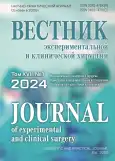Personalized Approach to the Treatment of Pilonidal Disease Complicated by Multiple Fistulas of the Coccygeal-Sacral Gluteal Region
- Authors: Korablina S.S.1, Lavreshin P.M.1, Gobejishvili V.K.1, Vladimirova O.V.1, Gobedzhishvili V.V.2, Korkmazov I.K.3, Chotchaev M.K.1, Shamirov S.V.1
-
Affiliations:
- Stavropol State Medical University
- I.M. Sechenov First Moscow State Medical University
- North Caucasian State Academy
- Issue: Vol 17, No 1 (2024)
- Pages: 17-23
- Section: Original articles
- URL: https://journal-vniispk.ru/2070-478X/article/view/254455
- DOI: https://doi.org/10.18499/2070-478X-2024-17-1-17-23
- ID: 254455
Cite item
Full Text
Abstract
Introduction. Pilonidal disease (pilonidal sinus, epithelial pilonidal sinus) is a common pathology detected by surgeons and coloproctologists. The disease is observed in 3-5% of the population. The vast majority of patients with pilonidal sinus are operated on under 30 years. Postoperative complications occur in 13-24% of patients, and 6-30% have relapses of the disease.
The aim of the study was to improve the treatment results of patients with pilonidal disease complicated by multiple fistulas of the coccygeal-sacral-gluteal region by developing new surgical treatment options, prediction and prevention of pathological scarring.
Materials and methods. The study involved 141 patients with pilonidal disease complicated by multiple fistulas of the coccygeal-sacral gluteal region. Depending on the treatment options used, all patients were divided into 2 groups: 45 (31.9%) patients were treated with conventional techniques; a comprehensive personalized approach was used in 96 (68.1%) patients. A developed personalized approach to the treatment of pilonidal disease included: predicting pathological scar formation (studying the acetylator properties of the body, the concentration of acute phase inflammatory proteins in the peripheral blood); performing original surgical procedures considering prevalence of the inflammatory process, the shape of the gluteal structure, the wound size after excision of the pilonidal sinus, pathologically altered tissues in the gluteal region. Therapeutic measures were aimed at preventing pathological scar formation
Results. A comparison of the immediate and long-term treatment results of patients with pilonidal disease complicated by the sacrococcygeal-gluteal region fistulas, who were exposed to the comprehensive treatment, demonstrated that their parameters were markedly better than those received conventional treatment: the number of early postoperative complications reduced from 17.8 to 6.3% (P<0.05); relapses - from 11.1 to 3.1% (P<0.05), development of excessive scar formation - from 35.6 to 4.1% (P<0.05); complaints of discomfort – from 17.8 to 6.3% (P<0.05). The duration of hospital treatment decreased by 4.1 days (P<0.05), and the period of complete healing reduced by 11 days (P<0.05).
Conclusions. To obtain adequate short-term and long-term results in the treatment of patients with pilonidal disease complicated by multiple fistulas, the following steps are required: thorough preoperative preparation; an individual approach to choose a surgical option considering the prevalence of the inflammatory process, the topographic and anatomical structure of the coccygeal-sacral gluteal region; a postoperative wound size; rational management of patients in the postoperative period. Study of the dynamics of proteins in the acute phase of inflammation and the acetylator activity of the body helped reveal a group of patients with a predisposition to pathological scar formation, who then were performed timely anti-scar therapy.
Full Text
##article.viewOnOriginalSite##About the authors
Sofya Sergeevna Korablina
Stavropol State Medical University
Email: Korablina_s@mail.ru
ORCID iD: 0000-0002-5113-2543
Ph.D., Associate Professor of the General Surgery Department
Russian Federation, Stavropol, Russian FederationPeter Mikhailovich Lavreshin
Stavropol State Medical University
Email: 89280075502@mail.ru
ORCID iD: 0000-0001-7839-5995
M.D., Professor, Head of the General Surgery Department
Russian Federation, Stavropol, Russian FederationVladimir Kishvardievich Gobejishvili
Stavropol State Medical University
Email: gobshah@mail.ru
ORCID iD: 0000-0002-0377-6205
Ph.D, Associate Professor of the General Surgery Department
Russian Federation, Stavropol, Russian FederationOksana Vladimirovna Vladimirova
Stavropol State Medical University
Email: oxy_8181@mail.ru
ORCID iD: 0000-0002-7375-8950
M.D, Associate Professor of the General Surgery Department
Russian Federation, Stavropol, Russian FederationVakhtang Vladimirovich Gobedzhishvili
I.M. Sechenov First Moscow State Medical University
Email: Walker87@list.ru
ORCID iD: 0000-0002-8883-4952
Ph.D, Associate Professor of the Department of Surgery
Russian Federation, Moscow, Russian FederationIlyas Khamzatovich Korkmazov
North Caucasian State Academy
Email: korkmaz@gmail.com
ORCID iD: 0000-0001-7134-0289
Assistant at the Department of Surgical Diseases with a Course in Topographic Anatomy
Russian Federation, Cherkessk, Russian FederationMarat Kazbekovich Chotchaev
Stavropol State Medical University
Email: chotcha.mk@gmail.ru
ORCID iD: 0000-0002-6546-8646
M.D, Associate Professor of the General Surgery Department
Russian Federation, Stavropol, Russian FederationStepan Vladimirovich Shamirov
Stavropol State Medical University
Author for correspondence.
Email: Shamirov59@mail.ru
ORCID iD: 0009-0001-2523-3594
Assistаnt of the General Surgery Department
Russian Federation, Stavropol, Russian FederationReferences
- Rhiannon L. Harries, Abdullah Alqallaf, Jared Torkington, Keith G. Harding. Management of sacrococcygeal pilonidal sinus disease. International Wound Journal. 2019; 16(2):370-378. doi: 10.1111/iwj.13042
- Peiliang Wu, Yingyi Zhang, Yewei Zhang, Shuang Wang, Zhe Fan. Progress in the surgical treatment of sacrococcygeal pilonidal sinus: a review. Int J Surg. 2023; 109(8):2388-2403. doi: 10.1097/JS9.0000000000000447
- Tuba Atak. Primary closure method after asymmetrical excision of a pilonidal sinus treatment: A retrospective cohort study. J Surg Med. 2023;7(9):564-567. doi: 10.28982/josam.7904
- Doll, D. New Attempt to Reach a Common Sense in Pilonidal Sinus Therapy. Dis. Colon Rectum. 2019; 62 (6):36-38.
- Shubrov EN, Baryshev AG, Triandafilov KV, Aladina VA, Fedyushkin VV, Amirova RK. Analysis of the Outcomes of a New Method for Plastic Surgery for Postoperative Wound Of Sacrococcygeal Region after Excision of the Pilonidal Cyst: Randomized Trial. Kubanskii Nauchnyi Meditsinskii Vestnik. 2022; 29(5):80-93. (in Russ.). doi: 10.25207/1608-6228-2022-29-5-80-93
- Brezhnev SG, Zhdanov AI, Korotkikh NN, Korotkikh KN. Statistical analysis of risk factors for wound failure after pilonidal sinus excision. Koloproktologia. 2018; 2(64):12-13 (in Russ.).
- Khubezov DA, Lukanin RV, Ogoreltsev AYu, Puchkov DK, Serebryansky PV, Yudina EA, Krotkov AR, Khubezov LD. Choice of surgical treatment for pylonidal disease without abscission. Khirurgiia. Zhurnal imeni N.I. Pirogova. 2019; 8(2); 24-31. (in Russ). doi: 10.17116/hirurgia 201908224
- Kutsay NV, Gavrilenko SP, Drevetnyak AA. Comparative characteristics of methods of surgical treatment of sacrococcygial pilonidal sinus based on a meta-analysis. Nauchno-obrazovatelnyi zhurnal dlia studentov i prepodavatelei «StudNet». 2021; 4(6):1388-1395.(in Russ.).
- Nechai IA, Bozhchenko AA, Maltcev NP, Vetochkin VА, Yakunina MYu. Surgical treatment of pilonidal disease with the use of «closed» techniques. Grekov's Bulletin of Surgery. Vestnik khirurgii im. I.I. Grekova. 2022, 181(2): 33-38. (in Russ.). doi: 10.24884/0042-4625-2022-181-2-33-38
Supplementary files









